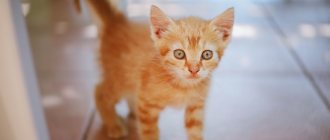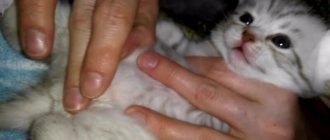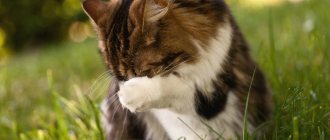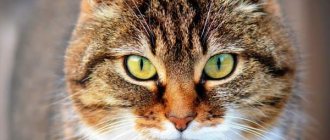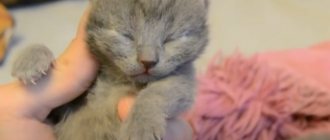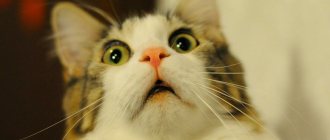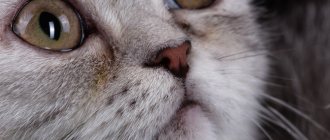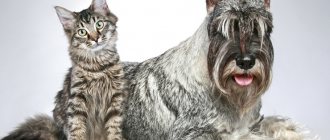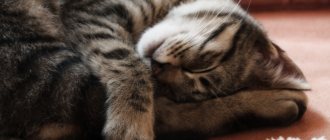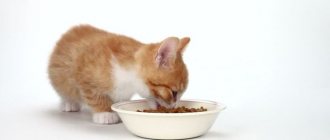Kittens are born small and completely helpless, then at first all the difficulties fall on the shoulders of the mother cat, but then 3 weeks passed and she needed the help of her owner in order to cope with these little fidgets. At three weeks of age, babies begin to move, they already see, hear, and go to the toilet on their own. Now the owner will have more problems related to caring for this wonderful creature. In addition to the question of how to protect the little fidget, a person will have another question: how to teach a kitten to eat on its own. In our article we will talk about at what age he begins to eat on his own, and how his diet needs to be changed.
How do newborn kittens feed?
Newborns are fed by the mother, as her colostrum is the most nutritious and safest feeding option. Alternative feeding methods are only permissible if the mother cat does not have breast milk.
Mother's milk
In addition to the nutrients needed for normal growth, breast milk imparts passive immunity. It protects newborns until the first vaccination, that is, up to 2-2.5 months.
This feeding method is the most optimal, since human participation is minimized. It is important for the owner to care only about the quality of the new mother’s nutrition.
Artificial feeding
Before starting artificial feeding, it is better to consult a veterinarian. The stomach of newborns is very small, so it is important to correctly calculate the daily dose.
Babies are fed special formulas that imitate cat's milk. Consumption of goat and cow's milk is not recommended, as these types do not contain the required amount of nutrients and can cause digestive problems.
In the first 2 weeks, furry pets are given warmed milk from a pipette 8 times a day every 2-3 hours. At week 3, they are accustomed to the nipple, reducing the number of feedings to 7 and introducing a five-hour night break.
Classification and features of industrial feeds
On mobile, you can scroll the table horizontally with your finger.
| Name | Advantages | Flaws |
| Economy class Diamond meal Doctor Zoo Vaska Whiskas Darling, etc. | low cost |
|
| Premium class Nutro nuggets Flatazor Pro Pac Happy Cat Royal Canin Doctor Alders, etc. |
|
|
| Super-premium class ProPlan Petreet Hills Nutro Choice Royal Canin Bosh, etc. |
| the cost is quite high |
| Holistics Innova Acana Canidae Eagle Pack Holistic Select Felidae, etc. |
| the cost is high, not affordable for everyone |
Economy or medium class food refers to a type of industrial food that is secretly called fast food for representatives of the cat world. This is the cheapest, most budget option, which has many disadvantages. Such food is made from the cheapest, low-quality products.
There is practically no meat in the composition. The meat part is represented mainly by waste. To enhance the taste of these products, chemical preservatives, flavor enhancers, flavorings, as well as catnip, which is an analogue of valerian, are added to the composition. Giving such food on a regular basis is highly discouraged, as this can lead to serious problems with the digestive system and health of the animal.
Super-premium class - they cost more than economy class, but they do not always meet the requirements. The advantage of such foods is that they do not contain food colors or flavors. They contain more meat than in economy category feeds, and the taste is a level higher. These types of feeds are quite well accepted by the animal’s digestive system.
Holistics are the most expensive class of cat food, but their quality is appropriate. The composition contains a large amount of natural, good meat. No dyes or flavor enhancers. The composition of the food fully corresponds to natural nutrition.
Recommended canned foods
On mobile, you can scroll the table horizontally with your finger.
| Name of food | Advantages | Flaws |
| Bosh Sababelle Super premium class |
| The food contains large quantities of maize and cellulose - components that can provoke a food allergy in a kitten. |
| Pro Plan Junior Premium class |
| The composition contains a high concentration of protein of plant origin. The food contains corn and soy - products that provoke allergic reactions. Preservatives are also present in the composition. |
| Hills Premium class |
| A high concentration of carbohydrates, which are poorly absorbed by the kitten’s digestive system, there are components that can cause allergies, canned food contains a lot of water and broth. |
At what age do kittens begin to eat on their own?
Some animals can allow cubs to breastfeed for up to 6 months, but most often breastfeeding stops at 3 months. Despite this, the first complementary foods are introduced at 1-1.5 months. By this age, the amount of breast milk decreases, and the cat begins to avoid the cubs and more often get out of her house. The most responsible parents show the location of the kitchen, showing their offspring their own bowls.
Due to lack of food, babies begin to look for other sources of nutrition and respond positively to complementary foods. They gradually develop teeth that help them chew harder foods.
Nutritional features of kittens
The baby has a growing and developing body that requires the necessary microelements and vitamins. In the first few weeks after birth, the kitten receives nutrients from its mother's milk. The frequency of meals is up to 10 r. per day. For kittens older than one month of age, the number of servings gradually decreases, because after a few months, when the kitten is weaned and it must learn to feed itself, it is important not to overfeed the small pet. And also make sure that the diet always contains the substances necessary for the development and strengthening of teeth and bones, nerves, the cardiovascular system, digestion, and vision. These include:
- calcium;
- vitamins, especially A, groups B, C, D, E;
- phosphorus;
- magnesium;
- potassium;
- iron;
- copper;
- manganese;
- iodine;
- sodium;
- biotin;
- taurine
When can kittens eat themselves?
Kittens begin to feed on their own after all their teeth have erupted and they have begun to walk more or less confidently.
It all depends on the conditions in which the kitten lived. Street animals survive by quickly adapting to the food they find, so the baby has to eat solid food already at the age of less than 1 month. This happens due to malnutrition of the mother cat, which has little milk. Domestic animals later become independent, mainly from the second and even the third month, when the kitten begins to eat on its own and has teethed. In time, this coincides with the fact that the babies begin to walk firmly and the owner needs to let them out of the box. During this period, you can already enrich the diet with dry food by soaking it a little in milk.
Rules for introducing complementary foods
Sudden variety is dangerous for a one-month-old baby, so all new products are introduced gradually. Give him no more than one new food every day. This will help track an allergic reaction.
The first complementary foods are given directly from the finger. With the approval of the mustachioed pet, a small portion is mixed into the already familiar food.
At first, all products are pureed. Solid foods are served only after baby teeth appear, that is, at about 2 months. At this age, in addition to slimy porridges, kefir, soft cottage cheese and pureed boiled vegetables, you can add finely chopped meat (lean beef, chicken, turkey, rabbit). Before serving, it must be thoroughly frozen and boiled.
All food should be warm, since too high and low temperatures are harmful to the mucous membranes of the esophagus, stomach and intestines. At first, it is recommended to avoid loud noises in the kitchen. In a calm environment, the baby will be more focused, and therefore will quickly begin to eat on his own.
Vitamins and supplements for three-week-old kittens
As soon as a three-week-old kitten begins to navigate in space, you need to try introducing complementary foods. In parallel with the introduction of complementary foods, the diet is enriched with vitamins and supplements.
The most important role in the nutrition of 3 week old kittens is played by proteins (proteins) and amino acids. Taurine is one of the rarest, but urgently needed amino acids for the normal development of kittens. Natural sources of taurine are:
- Homemade live yogurt.
- Whole milk.
Pharmacy vitamins can be added to the first complementary foods:
- Fish fat.
- Omega-3, Omega-6.
- B vitamins.
Pet stores sell commercial vitamin complexes for kittens, but they are intended for animals older than 1–2 months. If there are no alternatives, vitamins for kittens are crushed, dissolved in water and dosed by weight.
What, how much and how often to feed a kitten
Small pets are characterized by rapid growth. On average, they gain 10 g every day. Changes must be constantly monitored to prevent stunting. With proper and balanced nutrition, the likelihood of developmental problems is minimal.
At 1.5 months
At this age, breast milk is still the mainstay of the diet. Additionally, the menu includes:
- rice or semolina porridge, which promotes weight gain;
- boiled chicken or quail yolk;
- vegetable puree from zucchini, cabbage or pumpkin;
- chopped meat;
- low-fat cottage cheese, kefir and yogurt.
Food is given 7 times a day, excluding night feedings. This helps improve your sleep schedule. A single serving should be approximately 17 g, and a daily serving should be 120 g.
At 2 months
When teething, the diet is supplemented with solid food: finely chopped pieces of meat and fish. All of the above products are thoroughly boiled and removed from the bones. The number of feedings is reduced to 6, and the volume of the daily portion is increased to 150 g.
With the advent of solid food, you can refuse minced meat. Only liquid porridges and fermented milk products, which make up 50% of the entire diet, are preserved.
At 3 months
From 3 months to six months there is a rapid growth phase. Muscle mass and skeleton are actively developing. The portion is calculated based on the weight of the animal. For every kg there should be 200 g of food. The baby is fed 5 times a day. After vaccination, it is allowed to introduce boiled offal that has been deep frozen.
The amount of fermented milk products is reduced to ¼ of the diet, and milk is eliminated completely. The animal is given larger pieces of meat and the first raw vegetables (carrots, zucchini). When cooking porridges, reduce the amount of liquid, making them thicker.
Please note that, in addition to natural food, dry food is also acceptable. Choose lines designed specifically for kittens, but no less than premium ones. They are distinguished by their high calorie content and fortified composition. All standards are indicated on the packaging. Before the cloves appear, the granules will have to be soaked in warm water or milk formula.
Organization of self-feeding
Accustoming a kitten to self-feeding usually begins from the 3rd week. Experienced breeders consider the 25th day to be the optimal period.
Experienced breeders recommend starting to feed kittens from the 25th day
At what age do kittens begin to eat themselves?
Usually, from 3 weeks of age, a kitten is already lapping up milk formula from a saucer; from 4 weeks of age, if you plan to switch it to dry food, you can offer it kitten granules, soaking them in milk formula, or wet food. At the same time, the baby continues to eat mother's milk or formula.
How to determine if a kitten is ready
Under normal conditions, starting from the 4th week, the cat's milk production decreases. She begins to avoid the kittens and is absent from the nest for a long time, and the babies begin to instinctively look for additional sources of food. By this time, kittens can already move independently, navigate the terrain and have milk teeth. In most cases, the cat makes the task easier for the owner by bringing the kittens to their feeding place - the kitchen. If kittens are not fed, they will lose growth rates, lose weight, and become vocal as they begin to starve.
Bowl training rules
It is better to accustom kittens to the bowl together so that they develop normal socialization:
- Calculate the volume of the required milk formula, focusing on the instructions for it and the number of single servings.
- 2 hours before feeding, remove the cat from the kittens to improve their appetite.
- Invite the kitten to lick a finger moistened with the milk mixture, or use a teaspoon to place a small amount of the mixture on the kitten’s tongue, ensuring that it begins to lap on its own. You can’t dip a kitten’s face in a saucer - it can inhale milk and subsequently develop pneumonia. It should also be taken into account that cats’ noses are very sensitive, and the painful sensations received when accustoming to a bowl can, on the contrary, turn them away from it.
- After feeding the mixture, the kittens are returned to the cat for additional feeding.
Accustoming to independent feeding should take place gradually, while kittens should have the opportunity to supplement with mother's milk.
Video: first feeding for kittens
Solid food is introduced when the kitten can already lap from a saucer:
- Wet food: Mix two-thirds of wet kitten food with one-third of formula and keep the food at room temperature.
- Dry food: one part dry kitten food is mixed with three parts milk formula; over time, the amount of liquid in the food is gradually reduced so that from 5-6 weeks the kitten can eat only slightly moistened food, and from 8-10 weeks - completely dry baby food.
- With a natural type of food, the kitten is offered milk oatmeal or chicken or beef meat (a lump of boiled minced meat no larger than a pea). Complementary foods are introduced in small portions; It is recommended to start adding a new product after 2 weeks of starting complementary feeding, no more often than 1 new product every 3 days. After the introduction of a new product, the kitten’s condition is monitored especially carefully. To ensure proper nutrition with natural products, you should accustom your kitten to a variety of foods.
If your baby doesn't understand how to eat from a saucer, you can help him by putting food in his mouth with a spoon.
During the introduction of complementary foods, there is a risk of diarrhea in kittens. Its causes most often are:
- binge eating;
- poor absorption of the product introduced as complementary foods.
If diarrhea develops, you should:
- discontinue the administered product before the end of diarrhea;
- reduce the number of feedings with already introduced products;
- increase the proportion of mother’s milk in the kitten’s diet until stool normalizes;
- After stool normalization, re-offer the kitten a new product.
Diet during the transition period
The diet during the period of introducing complementary foods depends on whether the owner intends to feed the kitten with ready-made industrial food or natural food in the future. If you plan to use ready-made food, then you should choose a product for kittens produced by a trusted manufacturer:
- Orijen;
- Royal Canin;
- ProPlan;
- Eagle Pack Holistic Select.
For kittens, you should choose high-quality dry food that fully meets the needs of the growing body.
Those pet foods that are sold in regular grocery stores, even those produced by well-known brands (for example, Purina), are not suitable because they are in the lower price segment and do not have a balanced composition. The use of such food can harm not only a kitten, but also an adult cat. In particular, one of the “products” of such a diet was urolithiasis in cats, various types of inflammatory diseases of the digestive system and metabolic disorders.
Good food for kittens can only be bought in specialized veterinary stores and veterinary pharmacies. When buying food, you should save not on its composition, but by avoiding retail markups, for example:
- buy food in an online store and pick it up;
- purchase food by joining the order of the nursery, since there are discounts there;
- join one of the groups on social networks, which are usually curated by sales managers who give the group a discount for wholesale.
When purchasing food, you should always pay attention to its expiration date, and also take into account that a month after opening the bag, it loses its quality even with proper storage. You should never buy food in bulk, since it is not clear when the bag was opened or whether there is contamination with microbial pathogens.
When feeding kittens with prepared food, manufacturers recommend the use of both dry and wet food. Kittens receiving super premium food do not need vitamin and mineral supplements. When determining the portion for a single feeding, they are guided by the instructions for the food.
To feed kittens, we use products from trusted manufacturers.
When feeding a kitten naturally, the following is used to introduce it into its diet:
- boiled finely chopped meat or minced lean beef, chicken, turkey, rabbit;
- boiled fish without bones;
- dairy products: low-fat cottage cheese;
- yogurt;
- curdled milk;
- kefir;
With a natural diet, the kitten needs vitamins and mineral supplements, which are prescribed by the veterinarian. For the first four months of a kitten’s life, it definitely needs dairy and fermented milk products, which not only serve as a source of nutrition, but also prevent the development of intestinal dysbiosis. At the age of 5 months, a kitten can be switched to a diet for adult cats, maintaining 3 feedings a day. The total amount of food for a kitten per day should be 10% of its weight.
Up to 4 months, kittens need the presence of dairy and fermented milk products in their diet.
There are some features when transferring a kitten to self-feeding and using natural products:
- From the 9th week of a kitten’s life, on a natural diet, they begin to gradually increase the content of solid foods, while meat and vegetables are finely chopped, minced meat is no longer given. The porridge remains liquid. Half of the total diet should be fermented milk products and milk.
- At the age of 3 months: reduce the content of fermented milk products to one quarter of the diet, remove milk;
- meat and vegetables are cut even larger;
- porridge is cooked thicker;
- Offer the kitten raw vegetables (carrots, zucchini, potatoes).
Drinking regime
Kittens should have free access to clean drinking water, which is poured into small bowls, preferably a saucer. The water is changed several times a day. Kittens should have a permanent drinking water bowl so they know where to find it.
The kitten's kidneys are immature and their ability to concentrate is still very limited, so they lose water, releasing large amounts of unconcentrated urine, and make the kitten dependent on fluid intake.
In the absence of water, the kitten quickly develops a dangerous condition - dehydration, which is characterized by:
- loss of body weight;
- dry mucous membranes;
- brighter color of visible mucous membranes;
- decreased skin turgor - if you pinch the skin, the resulting fold does not straighten out (check at the withers).
Elimination of dehydration:
- identifying and eliminating its cause;
- providing the kitten with breast milk;
- if necessary, subcutaneous injections of isotonic solutions (5% glucose solution, 0.9% sodium chloride solution in volumes agreed with the veterinarian).
How to teach your baby to eat and drink from a bowl
At a young age, animals often copy the behavior of more experienced relatives. Their main authority is their mother. If a cat shows interest in raising offspring, then she herself teaches him all the basic skills. Otherwise, the owner will have to figure out how to teach the kitten to eat on its own.
For bowl training, use the following tips:
- Separate the cubs from their mother 2 hours before feeding. This will help them work up an appetite.
- Pour warm milk (36 °C) into a tablespoon and offer your pet a try. You can also use a regular finger and dip it in milk.
- If your pet drinks or licks the milk offered, pour a new portion into his bowl. Perform actions right in front of your baby. Having seen and smelled familiar food, he will definitely show interest in the container.
- Don't poke the animal's nose. This can cause unpleasant associations due to the increased sensitivity of the organ. Also, sudden inhalation of liquid can cause aspiration pneumonia.
- If the pet refuses to lap, repeat the second step. Stick your finger in the bowl and offer to try it again. Here you need to be patient. Soon the baby will understand what they want from him and will begin to eat himself.
During the meal, stop attempts to climb into the bowl with all four paws. If you frequently turn the container over, choose a more stable model. Do not use detergents that have a strong odor. Accompany every trip to the kitchen with the word “eat”, reinforcing positive associations. At first, be sure to return the pet to its mother for additional feeding.
Praise and Punishment
Remember that by bringing a kitten into your home, you have taken on responsibility. You have committed to put up with pranks, be patient, and be there if your pet gets sick. No child was brought up without punishment to a greater or lesser extent. You, as a “parent”, must be prepared to be tough.
Until the age of six months, the kitten is not punished, but ignored. If your child has done something wrong, be offended by him, turn away, change your tone. Give your pet the opportunity to independently recognize the wrongdoing. If the ward is deliberately naughty, you have to use the “whip”.
The best way to interrupt an unwanted action is noise. Buy a regular whistle, or just clap your hands. For example, if a kitten starts scratching the sofa, clap your hands and lightly slap it with a rolled-up newspaper. After such punishment, the baby will stop unwanted actions, and when he hears the clap, he will run away without waiting for the spank.
Features of feeding kittens at different ages
During the first days of life, the kitten feeds on mother’s milk until the age of two months.
Up to three weeks only the cat feeds. Otherwise, choose artificial nutrition. It could be: cow's milk, baby food, kitten formula (from a pet store).
From three to ten weeks is the time of transition from maternal nutrition to a varied diet. These days, the baby needs to be accustomed to porridge, it is better to start with semolina, then you can add fish, legumes, and meat products.
From three to four weeks, feed with various types of milk-based or water-based purees, but without meat and fish. These are cereals, potatoes, vegetables. Ready-made baby food products are suitable.
At two months solid food is introduced. But before serving food, you need to remove the bones from it. Cottage cheese and greens will also be useful. Vegetables can no longer be mashed, but grated.
After three months, the kitten is able to gnaw veins and small bones. It is allowed to include raw meat in the diet. But this step threatens the appearance of helminths. Therefore, meat foods can still be offered after heat treatment. Vegetables can be given in chopped form.
After five months of age, the kitten is ready to eat everything that adult cats eat. It is recommended to give grass that is easy to germinate at home on the balcony or windowsill. Sprouted wheat is suitable for this. It is a source of minerals and a tool for cleansing the stomach (regurgitating food).
Possible problems
In addition to observing the norms and frequency of feedings, it is important to avoid prohibited foods. They can lead to disturbances in the gastrointestinal tract, accompanied by complete refusal of food. An animal left without food for a long time may die.
Refusal to eat
If feeding problems occur in newborns, they must be checked by a veterinarian. Pathological reasons for refusing food at such an early age include:
- hypothermia, that is, low body temperature;
- intrauterine infection with leukemia, chlamydia or other dangerous diseases;
- too low weight associated with pathologies of the placenta;
- any intrauterine development disorders;
- internal injuries;
- hemolysis of newborns, accompanied by the destruction of red blood cells by antibodies supplied with colostrum.
If the baby has always had a good appetite, but increasingly refuses to eat after the introduction of complementary foods, then the problem may lie in:
- Stress
. Separating from the mother too early and abruptly switching to new food is harmful for the animal.
- Allergies
. An allergic reaction is accompanied by rashes, hair loss, redness of mucous membranes and other alarming symptoms. To normalize the condition, the allergen is excluded from the diet.
- Gastrointestinal disorder
. If vomiting and diarrhea occur, have your pet checked at a veterinary clinic. In addition to the usual eating disorder, worms or other parasites may be found in the body.
- Incorrectly selected dishes
. The pungent smell of plastic and the presence of dirt are unacceptable for clean representatives of the cat family.
If any alarming symptoms appear, be sure to contact your veterinarian. Kittens are more vulnerable than adult pets, so any delay can cost them their lives.
Prohibited foods
The list of prohibited foods includes everything that appears on the human table: spices, pickles, smoked foods, fried foods, flour and sweets. You should also exclude:
- pork, often contaminated with worms and causing obesity;
- millet and pearl barley porridge, poorly digestible in the stomach;
- grapes (raisins) and mushrooms that can lead to poisoning;
- garlic and onions, which contribute to the development of anemia;
- sorrel, which causes an acute form of gastritis;
- any bones that injure the esophagus and intestines when swallowed;
- a family of legumes that cause increased gas formation.
Milk is removed from the diet by the age of one year. Closely monitor your pet's reaction to this product. If lactose intolerance develops earlier, then it is not necessary to wait a year. This condition is accompanied by severe bloating and diarrhea, so it is difficult to miss.
Advice from experts on accustoming kittens to new food and bowls
Successful training in self-feeding largely depends on the dishes in which the kitten is offered food. It should be low, not slip on the floor, and the bowl must be clean. It is highly undesirable to wash it with the product. The fact is that kittens have a keen sense of smell, and foreign odors will only scare it away.
A lot in teaching a kitten to feed itself depends on the bowl in which the food is offered.
Experts also give the following recommendations for introducing complementary foods:
- New food should be introduced gradually, mixing it with the usual one.
- The consistency of the food should be thickened over time and only after the kitten laps from the bowl on its own.
- You need to carefully monitor the temperature of the food offered (it should be about 37 oC). Hot or cold food will scare the kitten away, and he may not return to the bowl any time soon.
- You should ensure a calm environment while the kitten is eating, excluding sudden sounds and movements of household members.
- If there are other pets in the house, it is advisable to exclude their access to the kitten while it is feeding.
Video: how to choose a bowl for a kitten
A few necessary recommendations
- It happens that the baby refuses to eat from the bowl if, for example, it is too low. You can buy a bowl at a pet store that sits on a special stand.
- A pet starting to feed on its own should always have access to clean water.
- In order to find out whether the animal has enough food offered, you need to periodically inquire about the contents of the tray. If the kitten visits him regularly, then everything is fine and he has enough food to eat.
A little patience and understanding, and within a week the furball will learn to feed on its own.
And it’s no longer so important at what age you teach your little pet to eat from a bowl; the main thing here is patience. There is no need to try to offer the tiny creature bread, potatoes or dry porridge, you just need to let him get used to food other than mother's milk
4 / 5 (1 vote)
What could the nickname be associated with?
Any name for a cat, as a rule, carries certain associations with its owner. And the nicer they are, the better, because saying something bad every day for many years is not a good idea. There were cases when names were chosen as a joke, giving them stupid or abusive nicknames. It is better to abandon such ideas.
The choice of name may depend on:
- breed and appearance;
- coat color;
- bright character traits;
- place of residence of the animal;
- time of year and month of his birth.
The gender of the animal largely determines the choice of name: the names of boys' cats should reflect the gradual transformation of the baby into a mustachioed and leisurely cat. Some nicknames are good for kittens, but not suitable for adult animals. This is why boys' cat names should be serious and respectable. The name for a cat should reflect the grace, femininity and elegance of the pet.
In addition, it is not forbidden to name your favorite based on your own hobbies. Many names for cats and cats appeared thanks to popular literary and cinematic characters, the names of actors and singers, and car brands. You can remember your favorite cities, childhood nicknames, car brands. Fantasy is limitless!
Many people look through a lot of names and, having not found anything original, decide that the best nickname for a cat is a human name. In this case, options are possible: from modern to rarely used and outdated. You can do this, but it is advisable that the animal does not have a real human prototype in order to avoid offense or misunderstandings. You can choose Japanese or English names for cats, which is also very original.
Sometimes they do the opposite, calling a black kitten Snowball, and a white one, on the contrary, Chernysh or Coal. There are funny cases when names for boys' cats are associated with girlish accessories - Bow, Stocking, Tube. Whatever the choice, one should not forget about appropriateness and euphony, because a name is given to an animal, like a person, for life.
Authorized Products
Small animals allowed on the menu:
- Meat – served raw, boiled or scalded with boiling water. Only low-fat varieties are suitable. Meat products should make up from 60 to 80% of the total daily food intake.
- Liver – no more than 2 times a week.
- Porridges – any are suitable, except semolina. All kittens are not fans of cereals, but they contain many substances that the growing body needs. It is recommended to mix meat and porridge in a ratio of 2 to 1.
- Vegetables - any, except potatoes, served boiled or raw.
- Chicken eggs - small pets can only be given the yolk. Its consumption is also allowed in raw form, but not more than once every 7 days. The yolk of quail eggs can be consumed simultaneously with the white.
- Fermented milk products - any, but with a minimum percentage of fat content. The exception is sour cream; giving it to kittens is strictly prohibited.
- Oil – not vegetable oil, but Vaseline is recommended.
- Brewer's yeast - affects the coat of a small pet.
It is recommended to give your kitten an apple as a fruit.
Useful nuances
Every happy owner should know these little things:
- A kitten of any age should always have access to clean water. You need to change the contents of the water bowl 2-3 times a day. Sometimes hair and food debris get into the water, which can cause the animal to refuse to drink and suffer from thirst.
- Kittens can get into the bowl with their paws, you can’t scold them for this. This is how kids enjoy the delicious food given by their beloved owner. If a person scolds a pet, the cat develops a fear associated with eating, and this then affects the upbringing of the baby.
- If your baby relieves himself regularly, it means he is getting enough food.
And the most important thing:
no need to worry too much. There are no cats who would prefer to live on milk all their lives. Sooner or later, the pet will stop its tricks and start trying new things.
Why is it worth weaning your cat off dry food?
This task can indeed be quite difficult. When looking for a way to wean a cat off dry food, many pet owners may encounter surprising stubbornness of the animal. Cat habits are much more stable than human ones, and therefore more difficult to fight. In addition, many people who have never dealt with these furry animals often simply do not know what to feed their domestic cat. What does she like? Can I give her soup, candy or milk? Another difficulty is that most manufacturers add a variety of flavor enhancers, flavors and food additives to their feed. Cats get so used to this “chemistry” that it is sometimes simply impossible to change their preferences. Compared to store-bought crackers, homemade food seems simply tasteless to them.
https://www.youtube.com/watch?v=ytaboutru
If you want to save money and buy cheap food for your animal, get ready to become a regular client of the veterinarian. Budget “drying” contains a record amount of carcinogens, which a priori will not add health to your pet.
If you are ready to think about how to wean your cat off food, then you already understand the disadvantages of canned food:
- Manufacturers add stimulants to the vast majority of feeds. The cat eats a lot, but does not become full.
- With this method of feeding, the animal’s stomach loses its ability to stretch. As a result, it becomes physically difficult for the cat to eat regular food.
- Even the most expensive brands of dry food are very far from ideal. They contain only chemical elements, nothing natural.
- Cat food of more or less passable quality costs a lot of money. If you are trying to feed your animal budget food, get ready to visit the veterinary clinic.
- Prepared cat food most often comes in the form of small pellets, pates, purees, or small pieces. The animal has absolutely no need to load its teeth. It just swallows the food. This is fraught with the appearance of tartar, plaque and other troubles.
- The cat eats the same food. The composition of the granules is almost the same. Only the smell is different, and even then not always. You can easily verify this by opening two or three packs of food with different flavors at the same time and comparing their contents.
If you are still not sure whether cats can eat raw meat, and prefer to make do with granules, study the list of troubles that store-bought “crackers” can cause your pet:
- vitamin deficiency - in the vast majority of dry food, the amount of vitamins stated on the pack does not correspond to the internal contents;
- renal failure - “crackers” are terribly salty, so the kidneys of many animals simply cannot cope with excreting such an amount of salt;
- dysbacteriosis – beneficial bacteria in the animal’s stomach die over time, and diarrhea may occur;
- allergies – if the cat’s food is not suitable, ulcers may appear and hair may fall out;
- poisoning - cheap food contains a lot of dyes that are not at all beneficial for the animal;
- oncology - most dry food contains monosodium glutamate (a very dangerous substance that can cause cancer).
Such food can cause a lot of problems, the most common of which include:
- vitamin deficiency – many dry foods do not contain sufficient amounts of certain vitamins that are so necessary for the pet and which are found in homemade food;
- dysbacteriosis – beneficial bacteria die in the stomach, and a disorder occurs;
- poisoning – your pet can be poisoned by various dyes that the food contains;
- heart and kidney diseases - since this food contains a lot of salt, the kidneys may be the first to suffer from it, because it is difficult for them to excrete them. Poor kidney function will, in turn, provoke heart failure;
- allergies – ulcers may appear in the animal’s mouth or hair may begin to fall out;
- cancer - most types of food contain monosodium glutamate, which is known to cause tumors.
